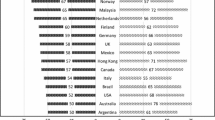Summary
The assumption that universities are the only natural home for basic research is questioned. The article examines the balance between teaching and research, considers the disadvantages of universities as places of research and suggests what is wanted in an institution devoted to research. The author proposes the creation of a new type of independent research institution which would have a special relationship with universities.
Similar content being viewed by others
References
Butcher, J. E. (1968). Human intelligence. London: Methuen.
Cattell, R. B. (1963). “The personality and motivation of the researchers from measurement of contemporaries and from biography.” In C.W. Taylor and F. Barron (Eds.), Scientific creativity. New York: Wiley, Chapter 9, pages 119–132.
Cattell, R. B., and Butcher, H. J. (1968). The prediction of achievement and creativity. Indianapolis, Indiana: Bobbs Merrill.
Cattell, R. B. (1972). A morality from science: Beyondism. New York: Pergamon Press.
Cattell, R. B., and Drevdahl, J. E. (1955). “A comparison of the personality profile (16 PF) of eminent researchers with that of eminent teachers and administrators and of the general population.” British Journal of Psychology, 46, 248–261.
Cattell, R. B., and Stice, G. F. (1960). The dimensions of groups and their relations to the behavior of members. Champaign, Illinois: IPAT.
Coleman, J., (1966). Equality of educational opportunity. Washington, D.C.: U.S. Office of Education.
Cross, K. P. (1970). The role of the junior college in providing post secondary education for all. Washington, D.C.: U.S. Office of Education.
Cross, K. P. (1971). “New students of the 70's.” Berkeley, California: The University of California; The Research Reporter, 6 1–5.
Drevdahl, J. E., and Cattell, R. B. (1968). Personality and creativity in artists and (Eds.), Scientific creativity: Its recognition and development. New York: Wiley.
Flexner, A. (1930). Universities: American, English, German. New York: Oxford University Press.
Gale Research Company. (1972). Research centers directory, 4th Edition. Detroit: Gale Research Company.
National Science Foundation (1972). Science Resources Studies: Highlights. Washington, D.C.: National Science Foundation.
Taylor, C. W., and Barron, F. (1963). (Eds.) Scientific creativity: Its recognition and development. New York: Wiley.
Taylor, C. W., Smith, W. R., and Ghiselin, B. (1963). “The creative and other contributions of one sample of research scientists.” In C. W. Taylor and F. Barron (Eds.), Scientific creativity: Its recognition and development. New York: Wiley, Chapter 5, pages 53–76.
Author information
Authors and Affiliations
Rights and permissions
About this article
Cite this article
Cattell, R.B. The organization of independent basic research institutes symbiotic with universities. High Educ 2, 1–14 (1973). https://doi.org/10.1007/BF00162533
Issue Date:
DOI: https://doi.org/10.1007/BF00162533




